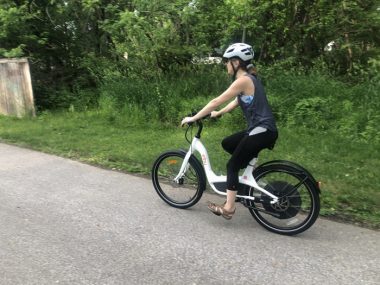How an Electric Bicycle Helps Me Conquer the Limitations of Chronic Fatigue

I bore down on the pedals as the pavement rose to meet me. Ahead, the tree-lined trail continued at a slow incline, swelling gradually as I glided uphill. With the push of a button, my pedaling took me farther. With the flip of a switch, I could be carried up the hill completely, no footwork required.
Last week, I took my new electric bicycle on its inaugural ride. There’s nothing like seeing the world from a bicycle seat, or the cleansing exhilaration of the wind on my face. Easing into the gentle curves of the trail, I allowed the repetitive pedaling motion to lull me into a sort of meditation.
When my battle with acute hepatic porphyria (AHP) became chronic, bike rides became energy expenditures I couldn’t afford. My body is sensitive to stress, including physical exertion. Vigorous exercise has provoked acute porphyria flares in my body.
There were times in the last few years I was willing to white-knuckle through the pain and exhaustion using sheer willpower. I was in denial about the true limitations of my rare disease and grasping for a taste of wind-whistling, heart-pounding trail endorphins. Unfortunately, the pain and overwhelming fatigue caught up to me, gradually becoming worse to the point that I could no longer justify a ride.
My history told in bicycles
I am privileged to have owned a bicycle at every stage of my life thus far. My love of bicycles began while buckled onto the back of my dad’s road bike. As a toddler, my ride of choice was a red tricycle. When I outgrew it, I switched to a pink bike with tassels on the handlebars and a banana seat.

Columnist Claire Richmond, then 8, poses with her new Huffy bicycle in 1992. (Courtesy of Eunice Richmond)
The training wheels came off when I was 7, and the following summer I upgraded to a larger purple and pink mountain bike.
Years later, when I was done growing and ready for a full-size bicycle, I began riding what would become my adventuring companion for more than a decade. I rode that bicycle on the streets of Columbia, Missouri, where I went to graduate school, Pensacola, Florida, where I served a year as an AmeriCorps VISTA, and Boston, Massachusetts, where I started my career in publishing.
Upon moving back to Iowa, it was time to upgrade. I bought a shiny new hybrid to commute around Iowa City, where I was attending graduate school.
Some of the first dates with my fiancé were spent on two wheels, zooming around the Des Moines metro’s trail system. In fact, the first piece of art we purchased together as a couple was a painting of bicycles we found at a boutique in Fort Collins, Colorado, while road tripping across the country.
Countless afternoons were spent on the backs of our bicycles picnicking in parks, exploring new places, enjoying a beer, discovering music, getting sunburned, and building friendships. With my recent chronic fatigue challenges, I’ve missed out on more than just a good workout in nature, I’ve missed bonding with my person and connecting with my community. It has taken a big toll on my mental health.
Finding the right e-bike for me
When I mounted my e-bike for its inaugural ride, my heart was fluttering with nervous excitement. At that point, it had been nearly two years since I was on a bicycle.
The decision to purchase an e-bike coincided with my acceptance of AHP as a constant, permanent challenge in my life. Shopping for an e-bike was relatively easy, as most bike shops in my area now carry electric bicycle options at various price points. E-bikes can get expensive; I squirreled money away for two years to afford mine.
What gives an e-bike its special powers? A computerized screen and two features I can control right from my handlebars: four levels of pedal assist and a throttle. Pedal assist is a great feature for speed and hills. But because I was purchasing an e-bike to conserve my energy, I looked for an option that also included a throttle. This narrowed down my search immensely. In fact, I only test rode two bicycles. I knew within the first 60 seconds that the Elby S1 9-Speed was the bike for me!

Claire rides her e-bike along Walnut Creek in central Iowa. (Courtesy of Michael Wagler)
In living with chronic fatigue and pain, I seek out ways to flatten the hills every day. My e-bike is a tool to access a small fragment of my pre-porphyria life. It’s also an investment in my mental health, and a promise to myself and my loved ones that I’ll do everything I can to be back on the trails.
***
Note: Porphyria News is strictly a news and information website about the disease. It does not provide medical advice, diagnosis, or treatment. This content is not intended to be a substitute for professional medical advice, diagnosis, or treatment. Always seek the advice of your physician or other qualified health provider with any questions you may have regarding a medical condition. Never disregard professional medical advice or delay in seeking it because of something you have read on this website. The opinions expressed in this column are not those of Porphyria News or its parent company, Bionews, and are intended to spark discussion about issues pertaining to porphyria.







Dan Ciha
Such a wise, inspiring story on how to acknowledge and deal with your disease while regaining some of what you so enjoyed in the past. Well done, Claire...
Claire Richmond
Thanks so much, Dan! It's a far cry from running long distances, but it absolutely is a huge gain! Your support means the world. - Claire